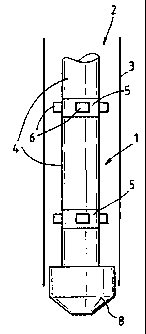Une partie des informations de ce site Web a été fournie par des sources externes. Le gouvernement du Canada n'assume aucune responsabilité concernant la précision, l'actualité ou la fiabilité des informations fournies par les sources externes. Les utilisateurs qui désirent employer cette information devraient consulter directement la source des informations. Le contenu fourni par les sources externes n'est pas assujetti aux exigences sur les langues officielles, la protection des renseignements personnels et l'accessibilité.
L'apparition de différences dans le texte et l'image des Revendications et de l'Abrégé dépend du moment auquel le document est publié. Les textes des Revendications et de l'Abrégé sont affichés :
| (12) Brevet: | (11) CA 2360192 |
|---|---|
| (54) Titre français: | TUYAUTERIE ET METHODE DE LUBRIFICATION |
| (54) Titre anglais: | A PIPE ASSEMBLY AND LUBRICATING METHOD |
| Statut: | Durée expirée - au-delà du délai suivant l'octroi |
| (51) Classification internationale des brevets (CIB): |
|
|---|---|
| (72) Inventeurs : |
|
| (73) Titulaires : |
|
| (71) Demandeurs : |
|
| (74) Agent: | MARKS & CLERK |
| (74) Co-agent: | |
| (45) Délivré: | 2008-06-10 |
| (86) Date de dépôt PCT: | 2000-01-07 |
| (87) Mise à la disponibilité du public: | 2000-07-20 |
| Requête d'examen: | 2002-10-29 |
| Licence disponible: | S.O. |
| Cédé au domaine public: | S.O. |
| (25) Langue des documents déposés: | Anglais |
| Traité de coopération en matière de brevets (PCT): | Oui |
|---|---|
| (86) Numéro de la demande PCT: | PCT/GB2000/000029 |
| (87) Numéro de publication internationale PCT: | WO 2000041487 |
| (85) Entrée nationale: | 2001-07-10 |
| (30) Données de priorité de la demande: | ||||||
|---|---|---|---|---|---|---|
|
Cette invention a trait à une tuyauterie (5), utilisable dans un forage (3), possédant plusieurs orifices de sortie (6) disposés, sur sa périphérie, à intervalle les uns des autres, sur le plan longitudinal, cet agencement permettant à un fluide de passer de l'intérieur vers l'extérieur de la tuyauterie.
A pipe assembly (5) for use in a wellbore (3) having a plurality of outlets
(6) positioned
about the periphery of the pipe at longitudinally spaced apart intervals for
allowing fluid to
pass from the interior to the exterior of the pipe.
Note : Les revendications sont présentées dans la langue officielle dans laquelle elles ont été soumises.
Note : Les descriptions sont présentées dans la langue officielle dans laquelle elles ont été soumises.

2024-08-01 : Dans le cadre de la transition vers les Brevets de nouvelle génération (BNG), la base de données sur les brevets canadiens (BDBC) contient désormais un Historique d'événement plus détaillé, qui reproduit le Journal des événements de notre nouvelle solution interne.
Veuillez noter que les événements débutant par « Inactive : » se réfèrent à des événements qui ne sont plus utilisés dans notre nouvelle solution interne.
Pour une meilleure compréhension de l'état de la demande ou brevet qui figure sur cette page, la rubrique Mise en garde , et les descriptions de Brevet , Historique d'événement , Taxes périodiques et Historique des paiements devraient être consultées.
| Description | Date |
|---|---|
| Inactive : Périmé (brevet - nouvelle loi) | 2020-01-07 |
| Représentant commun nommé | 2019-10-30 |
| Représentant commun nommé | 2019-10-30 |
| Lettre envoyée | 2015-01-08 |
| Inactive : Paiement - Taxe insuffisante | 2011-12-29 |
| Accordé par délivrance | 2008-06-10 |
| Inactive : Page couverture publiée | 2008-06-09 |
| Préoctroi | 2008-03-20 |
| Inactive : Taxe finale reçue | 2008-03-20 |
| Un avis d'acceptation est envoyé | 2007-12-10 |
| Lettre envoyée | 2007-12-10 |
| Un avis d'acceptation est envoyé | 2007-12-10 |
| Inactive : Approuvée aux fins d'acceptation (AFA) | 2007-11-28 |
| Inactive : Demande ad hoc documentée | 2007-10-23 |
| Inactive : Supprimer l'abandon | 2007-10-23 |
| Inactive : Abandon. - Aucune rép dem par.30(2) Règles | 2007-07-30 |
| Modification reçue - modification volontaire | 2007-07-27 |
| Inactive : Dem. de l'examinateur par.30(2) Règles | 2007-01-29 |
| Modification reçue - modification volontaire | 2006-06-15 |
| Inactive : CIB de MCD | 2006-03-12 |
| Inactive : Dem. de l'examinateur par.30(2) Règles | 2005-12-19 |
| Modification reçue - modification volontaire | 2005-09-23 |
| Inactive : Dem. de l'examinateur par.30(2) Règles | 2005-04-05 |
| Lettre envoyée | 2002-12-05 |
| Requête d'examen reçue | 2002-10-29 |
| Exigences pour une requête d'examen - jugée conforme | 2002-10-29 |
| Toutes les exigences pour l'examen - jugée conforme | 2002-10-29 |
| Lettre envoyée | 2002-07-03 |
| Lettre envoyée | 2002-07-03 |
| Inactive : Transfert individuel | 2002-05-10 |
| Inactive : Lettre officielle | 2002-03-05 |
| Inactive : Page couverture publiée | 2001-12-10 |
| Inactive : Correction au certificat de dépôt | 2001-12-03 |
| Exigences de dépôt - jugé conforme | 2001-12-03 |
| Inactive : Lettre de courtoisie - Preuve | 2001-11-27 |
| Inactive : Notice - Entrée phase nat. - Pas de RE | 2001-11-19 |
| Inactive : CIB en 1re position | 2001-11-19 |
| Demande reçue - PCT | 2001-11-08 |
| Demande publiée (accessible au public) | 2000-07-20 |
Il n'y a pas d'historique d'abandonnement
Le dernier paiement a été reçu le 2007-12-17
Avis : Si le paiement en totalité n'a pas été reçu au plus tard à la date indiquée, une taxe supplémentaire peut être imposée, soit une des taxes suivantes :
Veuillez vous référer à la page web des taxes sur les brevets de l'OPIC pour voir tous les montants actuels des taxes.
Les titulaires actuels et antérieures au dossier sont affichés en ordre alphabétique.
| Titulaires actuels au dossier |
|---|
| WEATHERFORD TECHNOLOGY HOLDINGS, LLC |
| Titulaires antérieures au dossier |
|---|
| GEOFFREY NEIL MURRAY |